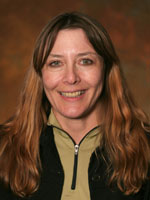
Deborah Charych
Chiron Corporation
The Advantages of Being Landlocked
A review of current Gordon Conferences reveals a wonderful mix of the venerable and the innovative. My first GRC experience was a new conference held at Colby-Sawyer College in 1996 called Chemical Sensors and Interfacial Design (CS&ID), organized by Dick Crooks, from Texas A&M University, and Tony Ricco, then at Sandia National Laboratories. CS&ID evolved from the long-standing Electrochemistry Conference and reflected the growing field of organic-based sensing devices, including electrochemical mechanisms.
In 1996 my lab at Lawrence Berkeley National Laboratory was just coming into its own. I was honored to be invited to speak at my first Gordon Conference because
I knew how prestigious GRC was. Through the CS&ID meetings I connected with and visited fellow National Lab scientists Ricco and Basil Swanson (from Los Alamos). From those interactions I realized that my work on polymeric colorimetric biosensors, in addition to its application to medical diagnostics (which had been my focus), could be applied to the important security problem of biological warfare agent detection. The off-the-record policy of GRC allowed the national need for chemical and biological sensors to come to the fore, even before the events of 11 September 2001. These discussions undoubtedly changed the direction of my research.
I remember an amazing talk by Jed Harrison from the University of Alberta at the 1996 CS&ID meeting. It was the first seminar I had seen on the emerging area of microfluidics, and Jed had cool videos that went along with the great science. At the 2000 CS&ID meeting Michael Ramsey, from Oak Ridge National Laboratory, gave a talk on microfluidics that was a treat. Clearly the field was taking off. By 2001 the microfluidics community had a conference of its own–the Physics and Chemistry of Microfluidics. This is a great example of a spin-off conference that reflects the changing avenues of science.
I became a regular at the CS&ID Conference and was elected vice chair for the 2000 meeting in Ventura, California, chaired by Tom Mallouk. Nate Lewis’s talk on vapor sensing using conducting polymer arrays was particularly inspiring and gave me the idea to use our colorimetric polymers in a similar vein. I could not get home fast enough! I am sure many attendees during the course of a Gordon Conference week have felt the same excitement about getting back home to pursue new ideas.
GRC is about innovative science, but it is also about people. The “free afternoons” are designed to allow casual interactions that may lead to future scientific collaborations. As vice chair of the 2000 CS&ID meeting I was charged with directing the social activities of the conferees during their free time–a task I took very seriously. I considered what to do with all the foreign scientists visiting the Golden State and came up with the perfect afternoon outing–a whale-watching trip. What better way to take advantage of our seaside location in Ventura? A boat was chartered, the conferees filed onboard, and we set sail on the turbulent waters of the Pacific. About thirty minutes into the voyage, not a single whale was sighted, but I noticed several of my colleagues turning an unusual shade of green. Soon after, eminent professors and graduate students alike were spotted recycling their lunch back to the sea. Two hours of abject misery and still no whale–not that anyone would have cared. For better or worse the “Whale Watching Trip from Hell” became part of CS&ID lore. I am convinced that communal suffering solidified the bond between attendees: many of them came back to the conference I chaired in 2001 in (mercifully landlocked) Il Ciocco, Italy.
The first CS&ID conference in 1996 cemented an emerging field of research and jump-started my own scientific career. I left academia to begin a new career in biotechnology, but I try to adopt the spirit of the GRC anytime I give a talk. Today I am honored to serve on the GRC board of trustees, and I look forward to seeing GRC lead the future of science in the next seventy-five years and beyond.